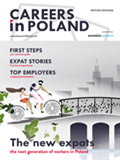A woman’s place is abroad


A woman’s place is abroad
related articles
Today, we are witnessing one of the biggest migration flows of all time. Unfortunately, the sad reality is that great numbers of people have to flee their countries and seek asylum in order to save their and their families’ lives. Thousands of refugees are being forced to leave their homes due to political reasons, environmental changes or social unrest. On the other side of the spectrum are the lucky ones – expats who just wish to travel the world, explore new cultures, improve their personal and professional lives. The last group seems to be continuously growing in size. Why do so many employees want to relocate for work? Are women given the same opportunities as men when it comes to international assignments? In order to find the answers, it is first necessary to understand the changing dynamics of the modern workplace.
TODAY’S WORKPLACE
The term “millennials” has been tossed around a lot in the past years – it would be no stretch to say that they are the most researched generation in history. Born in the 1980s and 1990s, millennials (otherwise known as Generation Y) were the first generation to grow up with computers and internet access – hence, their innate tech-savviness. Millennials are no strangers to multitasking and often seek new challenges at work. They expect the employer to provide them with professional training and development programmes. If entrusted with meaningful and interesting tasks, millennials make for very engaged employees. If not – they are ready to seek new opportunities in the candidate-driven market. However, Generation Y has not yet taken over the workplace – in fact, most employers today need to balance the expectations of multigenerational teams. Fresh university graduates often cooperate with their more experienced colleagues, the post-war baby boomer generation, which is said to be independent, self-reliant and dedicated. Baby boomers tend to apply “big picture” thinking to problem solving and favour long-term stability over frequent job change – this generation seems to be very committed to both their workplace and the job role. Then there is Generation X, born between 1965 and the late 1970s, which has been witness to the rapid evolution of technology and feels at ease both in face-to-face and digital contexts. Just like millennials, members of Generation X tend to opt for those companies that invest in their development and allow for a certain amount of flexibility and autonomy at work. These employees seem diligent, hard-working and loyal to their companies – providing that the job is engaging enough to hold their interest. The youngest group in today’s workplace is known as Generation Z or Generation C – where the “C” stands for “connect, communicate, change”. Born in the mid-to-late 1990s (or even the early 2000s), they grew up with phones in their hands, constantly connected to the digital world. Members of this generation are said to be creative, open to challenges and new possibilities.
Needless to say, the above is an obvious simplification of the attitudes displayed by different generations of employees. However, it is worth taking these factors into account, to tap the full potential of all age groups and better recognise the needs and strengths of all employees. Such an overview may also help understand the nature of today’s expatriation and to see why some employees may be more willing to accept a job abroad than others.
Nowadays, it is common for large corporations to send their best talent to the company’s foreign branches and subsidiaries. Although more costly, the process of relocation may prove less challenging than recruiting and training new employees. Expatriates, on the other hand, can benefit from attractive financial incentives (a salary increase, additional benefits and relocation bonuses), enhance their skills and advance their careers in a new location.
EXPAT GENDER GAP
The new wave of employees is said to be the driving force behind many important changes in the 21st century workplace, such as the growing popularity of employee engagement strategies or flexible work arrangements. Driven by a sense of curiosity and purpose, millennials are more prone to “ job-hopping” and open to the idea of gaining international work experience. However, research has shown that, sadly, not all young employees are given the same chance to develop their career abroad.
According to the 2015 PwC report, “The female millennial: A new era of talent”, young female professionals are increasingly interested in overseas career opportunities: “Female demand for global mobility has quite simply never been higher with 71% of female millennials identifying they want to work outside their home country during their career.” Nonetheless, women are much less likely to relocate for work than men – as pointed out in another PwC report, “women only account for a meagre 20% of current international assignees, making them vastly under-represented amongst the internationally mobile population” (PwC, Modern mobility: Moving women with purpose, 2016). Similar are the findings of a BCG survey, “Women on the Move: Shaping Leaders Through Overseas Postings”. As noted by the researchers, around 55% of the female respondents expressed their willingness to relocate (including 44% of women with family responsibilities), but fewer than 30% of them had been offered such a chance by their employers.
It is often argued that companies consider female employees to be less interested in expat assignments than their male co-workers, assuming women would be more likely to decline the offer due to family obligations. However, as indicated in the examples above, the assumption has no foundation in fact. It seems then, there is still huge room for improvement when it comes to gender equality in corporate workplaces and overseas career opportunities. There can be little doubt that systemic barriers faced by women hinder their career advancement and, in consequence, may prevent them from pursuing higher-level positions in their organisations. All around the world, women are still largely under-represented in leadership positions within companies – breaking the expatriation glass ceiling could be a major step towards greater gender equality in the workplace.
BEST DESTINATIONS
Bearing all that in mind, it comes as no surprise that a growing number of women choose to self-initiate their relocation to a different country. In Europe, the Nordic countries are usually ranked among the most attractive destinations for female expats - after all, Finland, Sweden or Norway are well known for leading the way in gender equality.
However, it is also worth noting that Poland has made huge progress towards workplace equality in recent years. In 2019, the country was ranked among the top 10 of countries that are considered best for female employees, according to the PwC’s Women in Work Index. Thanks to its record low unemployment rate and one of the lowest gender pay gaps in Europe (5%), Poland scored higher in the ranking than Canada, Switzerland or the United States. Additionally, as reported by Eurostat in 2019, women hold around 47% of managerial positions in Poland, which is well above the EU average of 36%. Is it time to give Poland a chance?












